Naengmyeon was widely enjoyed in Joseon, especially in the royal court. King Gojong (고종, 高宗) (1852-1919) is particularly known for his love of the dish. As the king preferred softer, milder food, he used to have naengmyeon in a chilled dongchimi broth served with slices of meat, pine nuts and pear slices as a midnight snack. Records of the dish can also be found in other texts, such as the “Jinchan Uigwe” (진찬의궤, 進饌儀軌), the royal protocols for court banquets, and in the "Siui Jeonseo" (시의전서, 是議全書), a cook book published in late Joseon times.
Naengmyeon has many medicinal effects. These come from another one of the main ingredients in the dish, buckwheat noodles. According to the "Dongui Bogam" (동의보감, 東醫寶鑑), the best-known Joseon medical book, buckwheat strengthens the stomach and intestines and helps people regain their energy. The book also says that buckwheat noodles remove any dirty waste accumulated inside the inner organs. The dongchimi broth also helps with the digestion, thanks to the digestive enzyme contained in the white radish.
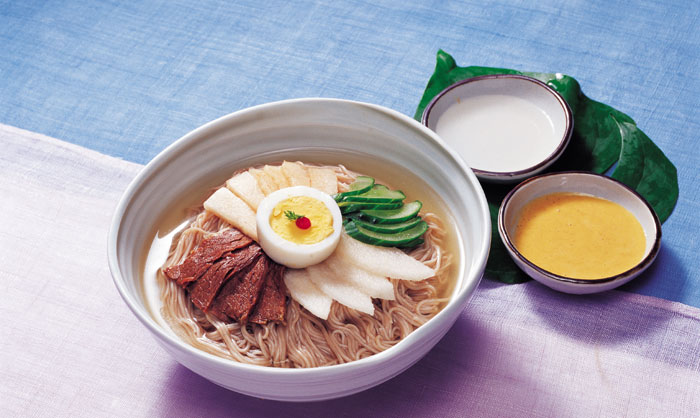
Naengmyeon is a noodle dish in a chilled broth. People used to love the dish, especially in the winter. The broth can be made with beef stock and dongchimi or dongchimi alone. In the summer, people also enjoy the dish with summer radish kimchi.
These days, the many different types of naengmyeon can be categorized by their home geography. Roughly speaking, people enjoy both Pyongyang-style naengmyeon, characterized for its buckwheat noodles in a clean dongchimi broth, and Hamheung-style naengmyeon, known for its hot and spicy seasoning. Hamheung naengmyeon is known for having chewy noodles, as the noodles are made from potato or sweet potato starch.
** Ingredients
400 g buckwheat noodles (dried)
3 kg (15 cups) water
300 g beef (brisket shank)
1.6 ㎏ (8 cups) water
fragrant seasoning:
20 g green onion
20 g garlic
seasoning sauce:
9 g (½ tbsp) clear soy sauce
24 g (2 tbsp) sugar
45 g (3 tbsp) vinegar
24 g (2 tbsp) salt
5.4 g (½ tbsp) fermented mustard
50 g cucumber
2 g (½ tsp) salt
15 g (1 tbsp) water
170 g radish
4 g (1 tsp) salt
12 g (1 tbsp) sugar
15 g (1 tbsp) vinegar
2.2 g (1 tsp) fine ground red pepper
100 g (1/5 ea) pear
100 g (½ cup) water
4 g (1 tsp) sugar
120 g (2 ea) egg
1 kg water
4 g (1 tsp) salt
10 g (1 tbsp) pine nuts
0.5 g shred red pepper
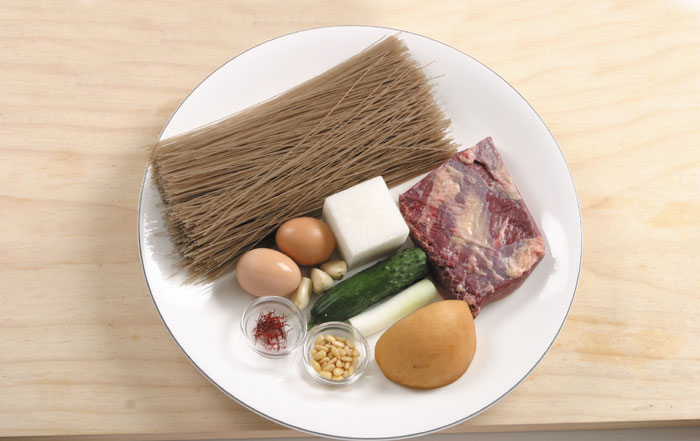
The main ingredients in naengmyeon are buckwheat noodles, beef, eggs, cucumber, green onion, white radish, garlic and pine nuts.
** Preparation
1. Clean the blood off the beef with a cotton cloth. Cleanly wash the fragrant seasoning.
2. Put the beef and water in a pot. Heat it for 10 minutes over high. When it boils, lower the heat to medium. Simmer for 1 hour. Add the green onion and garlic. Simmer for another 30 minutes.
3. Take the beef out of the broth. Slice it into pieces that are 4 centimeters wide, 2 centimeters long and 0.2 centimeters thick. After the broth cools down, skim off any fat and season with the seasoning sauce.
4. Wash the cucumber and halve it lengthwise. Slice it at 0.2-centimeter diagonal intervals. Soak it in salt water for 20 minutes, and then wipe away the water with a cotton cloth.
5. Shred the radish into slices that are 5 centimeters long, 2 centimeters wide and 0.2 centimeters thick. Marinate them with salt, sugar, vinegar and fine ground red pepper for 20 minutes. Peel the pear. Cut it into half-moon shaped pieces and dip them in sugar water.
6. Remove the tops of the pine nuts. Wipe the nuts with a dry cotton cloth. Cut the shredded red pepper into lengths that are 2-3 centimeters long.
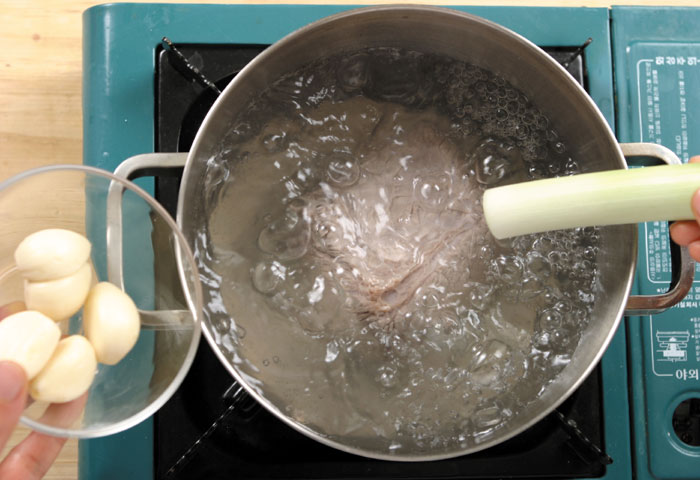
Boil the water and the beef in a pot over high for about 10 minutes. Lower the heat to medium and let it simmer for one hour. Add the fragrant seasoning and boil it all together over low for 30 minutes.
** Recipe
1. Put the eggs, water and salt in a pot. Heat it for 5 minutes over high. When it boils, lower the heat to medium. Boil it for another 12 minutes. Take out the eggs. Put them in cold water and then peel the eggshells. Cut them into two.
2. Pour water in a pot. Heat it for 12 minutes over high. When it boils, add the noodles. Boil it for 2 minutes. Take out the noodles and wash them in cold water. Make coils with the noodles and drain away the water using a strainer.
3. Place the noodles in a bowl and garnish them with beef, cucumber, radish, egg, pear, pine nuts and shredded red pepper. Pour the cold broth overtop.
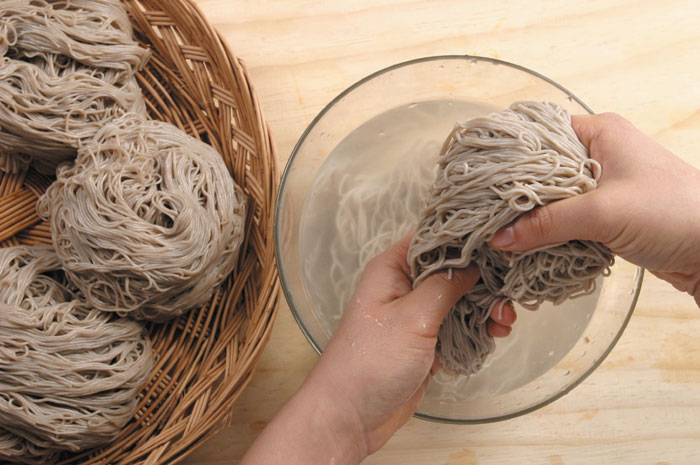
Put the noodles in boiling water for two minutes. Strain the noodles and rub them under cold water. Make noodle coils and drain away any excess water.
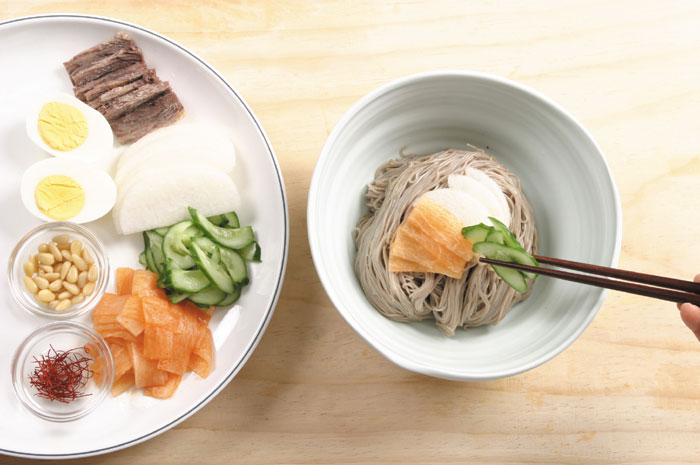
Put the noodles in a bowl and decorate it with beef slices, cucumber, radish, egg, pear, pine nuts and shredded red pepper. Pour the cold broth overtop before serving.
Managed by Yoon Sojung
Korea.net Staff Writer
In cooperation with the Institute of Traditional Korean Food (ITKF)
Content from “The Beauty of Korean Food: 100 Best-Loved Recipes”
arete@korea.kr